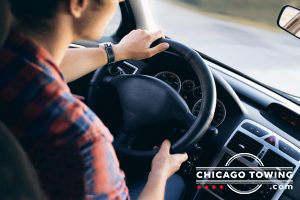Driving defensively is the best, and only right way to drive. When you do it you are prepared for all the unexpected happenings that might occur. Driving defensively allows you to take your safety into your own hands rather than those of the drivers around you. Here’s Chicago Towing’s guide to all the essentials of Defensive Driving.
Keep a Long Thrown Eye
Be aware of what’s down the road – make sure to watch down the road as far as your eye can see – thinking about the distances of miles, rather than feet. Don’t pay attention only to the car in front of you, but all the car’s in front of it too, as well as the oncoming traffic down the road. This way, you can quickly respond to the unexpected, an essential of all high speed driving.
Limit Distractions
Never eat when driving – and make sure to banish distractions like GPS systems radios, computers, texting, and phone calls. Driving distractions are a leading cause of automotive accidents and collisions, and even the most inconsequential actions like texting can amount to highly irresponsible driving behavior. A true defensive driver drives with undivided and total attention.
Escape Routes
Make sure to position your car or truck so you are visible to others, and always anticipate when you might have to turn or swerve. Don’t ever drive in another car’s blind spot. Be prepared for situations like when a var drifts into your lane, someone runs a red light, or if the driver in front of you suddenly stops. Be aware of a few escape routes at all times – for example, if the next door lane is available, if you can drive on the shoulder, if you need to speed up or slow down to accomplish these escapes. Be vigilantly aware of escape routes at all times, and eventually they will become natural to you.
Keep a Safe Distance
Keep a safe distance from the driver in front of you so you have sufficient reaction time, or time/room to escape if they suddenly stop. A great tool is the 3 second rule – choose a fixed object on the road, and once the car ahead of you clears that object, count to 3 – if your bumper clears that object within less than 3 seconds, you need to slow down and increase your following distance. In very rainy, snowy, or dark driving conditions, increase the distance to a range of 10 seconds.
Be Aware of What’s Around You
Keep checking your side mirrors and gaze down the road (as in Rule 1) to be alert of any aggressive or reckless drivers, as well as potential obstacles down the road. It’s essential to maintain awareness of any cyclists or pedestrians – taking extra care in crowded areas, during school hours, or during weekends or summer months.

